Papers by Dr. Anuj S Parihar
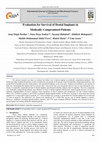
International Journal of Chemical and Biochemical Sciences, 2023
The present research was done to evaluate the failure rate of dental implant in medically comprom... more The present research was done to evaluate the failure rate of dental implant in medically compromised patients. This follow-up study included 40 patients in total, divided into two groups of 20 (group A had 20 medically compromised patients, and group B had 20 healthy persons), both genders, who had dental implants seven years prior. Failures were defined as any amount of bone loss surrounding the implant that was greater than 1 mm in the first year and greater than 0.3 mm in each subsequent year. Group A (medically compromised) had 42 dental implants and Group B (healthy subjects) had 44 implants. The most commonly seen medically compromised patients were diabetes (6) had 12 dental implants followed by cardiovascular diseases (5) had 11
implants, hypothyroidism (4) had 8 implants, organ transplant (3) had 6 implants and osteoporosis (2) had 5 dental implants. There were 12 (60%) in group A, and 2(10%) in group B, dental implant failures. At first year, in group A, mean bone loss around implant was 1.4 mm and 0.4 mm in group B. At 7 years of follow up, in group A, mean bone loss around implant was 2.8 mm and 1.2 mm in group B. The difference was found to be significant (P < 0.001).The success rate of dental implants is greater.
However, conditions including hypothyroidism, diabetes, and CVS make treatment difficult. Diabetes was reported to have a greater failure rate among medically impaired patients.
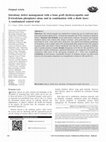
Tzu Chi Medical Journal, 2023
Objectives: The current research was conducted to evaluate the use of a diode laser and a bone gr... more Objectives: The current research was conducted to evaluate the use of a diode laser and a bone graft (hydroxyapatite [HA] + β-tricalcium phosphate [β-TCP]) in healing of intrabony defects.
Materials and Methods: In this split-mouth evaluation, 40 patients with bilateral intrabony defects were treated with, Group I (control)-bone graft alone (HA + β-TCP) and Group II, (test)-bone graft with a diode laser. The clinical and radiologic parameters of all patients, such as plaque index (PI), probing depth (PD), gingival index (GI), gingival recession (GR), and relative clinical attachment level (RCAL) were recorded at baseline, after 3 months and after 6 months.
Results: Reductions in PI, PD, GI, GR, and RCAL were found after 6 months. Furthermore, significant differences were displayed in the intra-group comparison while those of the inter-group evaluation (P > 0.05) were insignificant.
Conclusion: In both groups, considerable decrease in intrabony pockets was discovered; however, the inter-group comparison was insignificant in relation to GR and RCAL.
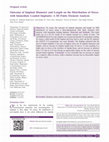
Journal of Pharmacy and BioAllied Sciences, 2023
Objectives: To assess the outcome of implant diameter and length on THE distribution of stress us... more Objectives: To assess the outcome of implant diameter and length on THE distribution of stress using a three-dimensional (3D) finite elements (FE) analysis, with immediate loading implants. Materials and Methods: This study made use of a 3D FE model of an implant encased in a chunk of bone. The LEADER/ITALIA-Fix type implant was created specifically for immediate loading. To create a solid model of the implant and bone and to carry out the FE analysis, the ANSYS V.12 programme was used. Results: The findings indicated that the neck of dental implants is the area of highest stress for all implant diameters and lengths, with an increase in implant length from 10 mm to 12 mm resulting in a slight raise in stress at the interface of implant-bone, and an increase in diameter from 3.75 mm to 4.25 mm having no appreciable impact on the value of stresses around dental implants. Conclusion: It was concluded that an increase in length has a negative effect on stress, while a diameter increase has no discernible impact on stress values.
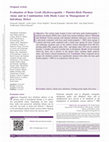
Journal of Pharmacy and BioAllied Sciences, 2023
The current study looked at how well bone graft (hydroxyapatite + platelet-rich plasma (PRP)) and... more The current study looked at how well bone graft (hydroxyapatite + platelet-rich plasma (PRP)) and a diode laser treated infrabony defects. Materials and Method: Twenty patients with bilateral infrabony deficiency were treated in a split-moth evaluation with bone graft (hydroxyapatite + PRP) alone (group I) (control) and bone graft combined with a diode laser (group II) (test). Clinical and radiologic measures such as the relative clinical attachment level (RCAL), probing depth (PD), gingival index (GI), and plaque index (PI) were recorded at baseline, 3 months later, and 6 months later in all patients. Result: At the 6-month follow-up, there was a decline in the plaque index, probing depth, gingival index, and relative clinical attachment level. Conclusion: When compared across groups, the intrabony pocket was significantly reduced with either the bone graft (hydroxyapatite + PRP) or in conjunction with the laser.
Journal of Pharmacy and BioAllied Sciences, 2023
This research was done to assess how much bone is lost around dental implants in smokers. Materia... more This research was done to assess how much bone is lost around dental implants in smokers. Material and Method: There were 80 participants total in the study, 40 of whom were smokers (Group I) and 40 of who were non-smokers (Group II). By evaluating the patients' clinical and radiographic data, the marginal bone-level measurements were determined. The acquired information underwent statistical analysis. Results: Smokers were found to have worse overall clinical parameters than non-smokers (P 0.05). Smokers experience more marginal bone loss around implants than non-smokers do. Conclusion: Smoking has a negative impact on the outcome rate of dental implants.
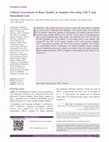
Journal of Pharmacy and BioAllied Sciences, 2023
Objectives: The current research was done to assess the bone quality at implant site using CBCT. ... more Objectives: The current research was done to assess the bone quality at implant site using CBCT. Materials and Methods: The present study was conducted on 50 partially edentulous patients of both genders. All subjects had their chests scanned using a Kodac machine set to 120 kVp, 12 mA, and a 17-second exposure time. Using Hounsfield units, bone quality was classified as D1, D2, D3, D4, and D5 (HU). Result: Out of 50 patients, 27 were males and 23 were females. The average HU was 786.1 at the anterior maxilla, 1174.3 at the anterior mandible, 332.1 at the posterior maxilla, and 742.4 at the posterior mandible. The variation was considerable (P-0.01). Conclusion: The anterior mandible, anterior maxilla, posterior mandible, and posterior maxilla were found to have the highest densities. Based on Hounsfield units, CBCT is helpful in determining the bone density at the implant site.
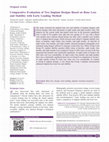
Journal of Pharmacy and BioAllied Sciences, 2023
The study evaluated the implant bone loss and stability of implant changes with diverse designs w... more The study evaluated the implant bone loss and stability of implant changes with diverse designs with early placement at eight weeks and eight months’ time. The subjects for the current study had partial tooth loss in the posterior mandibular arch. A total of 30 samples were split into two groups of 15, one with a flared crest module and a buttress thread design, the other with a parallel crest module and a V‑shaped thread design. Ostell assessed each subject’s implant stability four
times, at baseline, eight weeks, four months, and eight months. At intervals of eight weeks, four months, and eight months, intraoral periapical radiographs were examined using ImageJ software to measure crestal bone loss. When Group I and Group II’s implant stability quotient (ISQ) values at baseline, eight weeks, four months, and eight months were compared; Group I’s ISQ values at each of the four measured time periods were statistically significant. At eight weeks in Group I, the ISQ value was very considerable. At eight weeks, four months, and eight months, there was a statistically significant bone loss in Group II in comparison to Group I. At eight months, Group II’s bone loss value was very considerable. In contrast to Group II implant designs, it was found that Group I implants demonstrated enhanced implant‑less bone loss and stability.
Journal of Pharmacy and Bio Allied Sciences, 2023
Objectives: The goal of the current research was to compare the failure rate of dental implants i... more Objectives: The goal of the current research was to compare the failure rate of dental implants in medically compromised patients to healthy individuals.
Materials and Methods: In this seven years retrospective study, 50 patients from Group A who were medically compromised had 63 implants, while 50 patients from Group B who were healthy had 67 implants. Over 1 mm of bone loss around the implant in the first year and over 0.2 mm of bone loss per year after that were considered failure rates. Result: Two (2.9%) of the dental implants in Group B and 18 (28.6%) in Group A, both failed. The average bone loss around the implant in Group A during the first year was 1.21 mm, compared to 0.3 mm in Group B.
Conclusion: Uncontrolled diabetes mellitus group had greater implant failure.
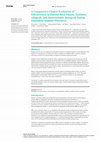
Cureus, 2022
Background: The use of an appropriate graft material helps in an adequate amount of osseointegrat... more Background: The use of an appropriate graft material helps in an adequate amount of osseointegration. The objective of this study was to compare the efficacy of platelet-rich plasma (PRP), a synthetic allograft (PerioGlas), and Bio-Oss, a bioresorbable xenograft in immediate implant procedures.
Methods: In this randomized, prospective study, 90 patients were categorized into three groups with 30 samples in each as Group A: patients who received PRP with an immediate implant; Group B: immediate implants with synthetic allograft (PerioGlas); and Group C: patients with immediate implants placed using bioresorbable xenograft (Bio-Oss). Postoperative follow-up was done based on plaque and gingival index, measurement of probing depths, and resorption of bone. Obtained data were statistically analyzed using the "one-way analysis of variance (ANOVA)" test.
Results: Inter-group statistical comparisons between gingival and plaque indices at three, six, and 12 months of follow-up in the study groups demonstrated no statistical significance (p > 0.05). The mean probing depths and resorption of bone at three, six, and 12 months of follow-up were statistically nonsignificant (p > 0.05) on the inter-group comparison.
Conclusion: It could be concluded from the present study that there is no statistical superiority observed among PRP, PerioGlas, or Bio-Oss in terms of their usage as a graft material along with immediate implant placement procedure.
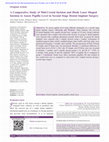
Journal of Pharmacy & Bioallied Sciences, 2022
Objectives: To assess papilla level using different techniques in a second stage dental implant s... more Objectives: To assess papilla level using different techniques in a second stage dental implant surgery.
Materials and Methods: Thirty patients who received 45 dental implants were equally divided into 3 groups of 10 each. Group I patients were operated with a scalpel with mid‑crestal incision. In group II, dental implants were exposed with a gallium–aluminum–arsenide diode laser. In group III, dental implants were exposed with I shaped incision using a scalpel. Assessment of modified gingival index (mGI), modified plaque index (mPI), and Jemt index were performed at baseline, 3 months, and 6 months. The measurement of FAJI, FAJAdj, ST height, and CP Bone crest was performed.
Results: A significant difference in crestal bone level of FAJ‑ I, FAJ‑ adj, ST height, and CP Bone crest was recorded at baseline, 3 months, and 6 months among groups I, II, and III (P < 0.05). At 6 months, both groups II and III exhibited >60% of papilla fill as compared to group I.
Conclusion: Diode laser offers maximum papillary fill and resulted in less crestal bone loss as compared to mid‑crestal and I shaped incision during a second stage surgery.
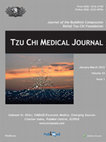
Tzu Chi Medical Journal, 2022
Objectives: The bone quantity and quality determine the prosthetic success outcome. This research... more Objectives: The bone quantity and quality determine the prosthetic success outcome. This research was performed to evaluate the bone density for insertion of pterygoid implants in edentulous and dentulous participants with cone-beam computed tomography (CBCT). Materials and Methods: CBCT evaluation was done for 66 dentate and edentulous patients for pterygoid implants at the pterygomaxillary region. The calculation of joint width, height, and volume of bone was done. Density of the bone was evaluated at the superior and inferior aspects of the pterygomaxillary column. Results: It was observed that average pterygomaxillary joint height for dentulous (dentate) was −12.7 ± 7.2 mm, edentulous −12.4 ± 7.1 mm, the average pterygomaxillary joint width for dentulous was 8.15 ± 7.3 mm, and 8.13 ± 6.2 mm for edentulous. The average pterygomaxillary joint volume in dentulous participants was 279.4 ± 189.2 mm 3 and for edentulous was 254.5 ± 176.4 mm 3. There was expressively greater density of the bone in dentulous participants over edentulous participants (P < 0.05). Conclusion: There was better bone density found in dentate participants in comparison to edentulous participants. CBCT is a recent investigative device which measures pterygoid area efficiently. Pterygoid implants may be deliberated as an alternative method for resorbed (atrophic) maxilla.
Annals of African Medicine, 2021
Predictable esthetic root coverage has evolved into conventional treatment modalities making cosm... more Predictable esthetic root coverage has evolved into conventional treatment modalities making cosmetic procedures an integral part of periodontal treatment. The advent of second‑generation platelet concentrates, i.e., platelet‑rich fibrin (PRF), has broad clinical application in medical as well as dental field with its recent use for recession defects. The simplicity of PRF procurement and its low cost makes it most suitable for use in daily clinical practice. This particular case report foregrounds the benefit of PRF membrane along with coronally repositioned flap for mucogingival surgery on the labial surface of an upper anterior tooth.
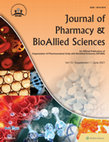
Journal of Pharmacy and Bioallied Sciences, 2021
The primary purpose of the study was to evaluate the levels of oxidative stress in plasma in pati... more The primary purpose of the study was to evaluate the levels of oxidative stress in plasma in patients with aggressive periodontitis (AgP) before and after full-mouth disinfection. Materials and Methods: Twenty-five healthy controls and 25 participants with aggressive periodontal were assessed for plaque index, probing pocket depth, papillary bleeding index, and clinical attachment level. Periodontal bone support was assessed by taking full mouth periapical radiographs. Full-mouth disinfection of the patient was done within 24 h of clinical assessment of AgP. These parameters were assessed at the baseline and after 8 weeks of initial periodontal therapy. Plasma samples were taken and evaluated for various oxidative stress markers. Results: Strong positive correlation was observed among periodontal parameters and levels of enzymatic/nonenzymatic biomarkers for oxidative stress (thiobarbituric acid-reactive substances [TBARS], glutathione peroxidase [GPX], and catalase [CAT]) (P < 0.05), before and after periodontal management. The patients with AgP had high levels of TBARS, GPX, and CAT levels in the plasma matched to the healthy individuals (P < 0.05). Conclusion: Enzymatic and nonenzymatic oxidative stress may have a role in the pathogenesis AP. Initial periodontal treatment can lead to the reduction of these stresses.
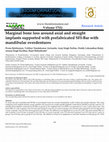
Bioinformation, 2021
To assess the role of prefabricated SFI-Bar in peri-implant bone loss around immediately axially ... more To assess the role of prefabricated SFI-Bar in peri-implant bone loss around immediately axially loaded and straight implants. This study comprised of 40 complete denture wearer patients who received two axially parallel implants connected by SFI-Bars in group I and two 15° mesially tilted implants connected by SFI-Bars in group II. Peri-implant bone loss (PiBL) was measured at 1 year, 2 years and 3 years. The mean PiBL at 1 year in group I was 0.21 mm and I group II was 0.22, at 2 years in group I was 0.26 mm and in group II was 0.23 mm and at 3 years, in group I was 0.29 mm and in group II was 0.34 mm. The difference was significant at 3 years (P< 0.05). The mean mesial PIBL at 1 year in group I was 0.18 mm, in group II was 0.20 mm, at 2 years in group I was 0.19 mm and in group II was 0.07 mm and at 3 years, in group I was 0.25 mm and in group II was 0.29 mm. The difference found to be significant in each time duration in both groups (P< 0.05).
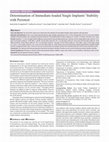
The Journal of Contemporary Dental Practice, 2020
Aim and objective: The aim of this study was to determine the stability of immediate-loaded singl... more Aim and objective: The aim of this study was to determine the stability of immediate-loaded single implants with periotest.
Materials and methods: In this in vivo study, dental implants with a length ranging from 10 to 13 mm and diameter of 3.0-4.2 mm were utilized. Stability of dental implant was evaluated using the Periotest® M handheld device before loading, at 1 month, 3 months, 6 months, and 1 year.
Results: Implants 11.5 mm in length had the highest mean periotest value (0) after placement, whereas 10 mm-long implant had a value of −0.31 and 13 mm had a value of −0.48. After 1 month, 10 mm had a value of 1.23, 11.5 mm had a value of −0.32, and 13.0 mm had a value of −0.24. After 6 months, 10 mm had a value of 1.78, 11.5 mm had a value of −0.4, and 13.0 mm had a value of −0.41. After 1 year, 10 mm had a value of −0.54, 11.5 mm had a value of −0.51, and 13.0 mm had a value of −0.48. There was an unconstructive relationship between implant length and the average periotest score. There was also an unconstructive association between the implant diameter and the mean periotest value.
Conclusion: The implant with long and greatest diameter had higher stability. Periotest can be used to determine dental implant stability. Clinical significance: Periotest is useful in determining dental implant stability. Large-scale studies may be helpful in obtaining useful results.
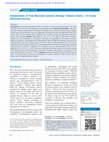
Journal of Orofacial Sciences, 2020
Introduction: Increased consumption of tobacco can lead to various oral mucosal lesions. The stud... more Introduction: Increased consumption of tobacco can lead to various oral mucosal lesions. The study was done to assess the oral mucosal lesions among tobacco users. Materials & Methods: This cross-sectional study was conducted on 5240 subjects who found to have a history of tobacco usage. Subjects with presence of oral mucosal lesions were subjected to vital tissue staining with toluidine blue dye (TB). Factors such as socioeconomic status, occupation, type of tobacco usage, education status and type of lesions were recorded. Results: Hyperkeratosis was seen in 562 patients followed by smoker's melanosis in 360, leukoplakia in 252 patients, squamous cell carcinoma in 190 patients, smoker's palate in 130 patients, erythroplakia in 96, lichen planus in 80 and OSMF in 70 patients. Cases were due to Cigarette/bidi, were due to gutkha usage, 252 (14.4%) due to hookah, hukli and 214 (12.2%) due to zarda/pan masala. Oral mucosal lesions were significantly higher in patients with the habit of smoking cigarette/beedi 974 (55.9%) compared to those patients that were chewing gutkha 300(17.2%) or panmasala 214 (12.2%) (P < 0.05). There was significantly maximum lesions seen in buccal mucosa (812) followed by the retromolar pad area in 302, floor of mouth in 199, palate in 176, gingiva in 128, tongue in 90 and lip in 33 cases (P < 0.05). Conclusion: Authors found that most common oral mucosal lesion was hyperkeratosis followed by leukoplakia and smokers melanosis. Most common type of tobacco use was cigarette/bidi and gutkha.
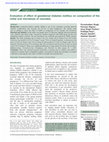
Advanced Biomedical Research, 2020
Background: Gestational diabetes mellitus (GDM) is one of the commonly occurring high‑risk obstet... more Background: Gestational diabetes mellitus (GDM) is one of the commonly occurring high‑risk obstetric complications that accounts for 4%–9% of total pregnancies. The present study was an attempt to assess the effect of GDM on composition of the neonatal oral microbiota.
Materials and Methods: In this study, oral samples from 155 full‑term vaginally delivered newborns were collected with sterile swabs. Seventy‑five mothers diagnosed with GDM group and 80 were
nondiabetic mothers (control). The oral microbiota was evaluated and analyzed by SPSS software.
Results: The mean gestational age in Group I was 38.1 weeks and in Group II was 39.6 weeks. Firmicutes was present in 38.1% in Group I versus 77.6% in Group II patients, Actinobacteria was seen in 15.2% in Group I and 7.4% in Group II, Bacteroidetes in 27.6% in Group I and 7.9% in Group II, Proteobacteria in 9.5% in Group I and 3.8% in Group II, and Tenericutes in 9.6% in Group I and 3.3% in Group II. There was a significant difference in major genera Prevotella, Bacteroidetes,
Bifidobacterium, Corynebacterium, Ureaplasma, and Weissella in both groups (P < 0.05).
Conclusion: There was increased bacterial microbiota in neonates born to mothers with GDM as compared to neonates born to nondiabetic mothers. Assessment of initial oral microbiota of neonates could help in assessing the early effect of GDM on neonatal oral microbial flora.
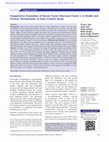
Contemporary Clinical Dentistry, 2020
Background: Tumor necrosis factor‑alpha (TNF‑α), a “major inflammatory cytokine,” not only plays ... more Background: Tumor necrosis factor‑alpha (TNF‑α), a “major inflammatory cytokine,” not only plays an important role in periodontal destruction but also is extremely toxic to the host. Till date, there are not many studies comparing the levels of TNF‑α in serum and its relationship to periodontal disease. Aim: Our study aimed to compare the serum TNF‑α among the two study groups, namely, healthy controls and chronic periodontitis patients and establish a correlation between serum TNF‑α and various clinical parameters. Hence, an attempt is made to estimate the level of TNF‑α in serum, its relationship to periodontal disease and to explore the possibility of using the level of TNF‑α in serum as a biochemical “marker” of periodontal disease. Materials and Methods: Forty individuals participated in the study and were grouped into two subgroups. Group A – 20 systemically and periodontally healthy controls. Group B – twenty patients with generalized chronic periodontitis. The serum samples were assayed for TNF‑α levels by enzyme‑linked immunosorbent assay method. Results: The mean serum TNF‑α cytokines for Group B Generalized chronic periodontitis (GCP) was 2.977 ± 1.011, and Group A (healthy) was 0.867 ± 0.865. The range of serum TNF‑α was from (0.867 to 2.977). Serum TNF‑α cytokines had highly significant correlation with all clinical parameters (plaque index, probing pocket depth, clinical attachment loss, and gingival index) among all study participants (P = 0.001). Conclusion: These observations suggest a positive association between periodontal disease and increased levels of TNF‑α in serum. It can be concluded that there is a prospect of using the estimation of TNF‑α in serum as a “marker” of periodontal disease in future. However, it remains a possibility that the absence or low levels of TNF‑α in serum might indicate a stable lesion and elevated levels might indicate an active site but only longitudinal studies taking into account, the disease “activity” and “inactivity”
Aim: To assess the survival rate of short dental implants in medically compromised patients. Mate... more Aim: To assess the survival rate of short dental implants in medically compromised patients. Materials and method: This follow-up study was conducted on 342 medically compromised patients of both genders (580 dental implants). The failure rate of dental implants was assessed.
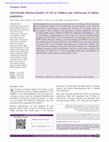
Journal of Pharmacy And Bioallied Sciences, 2020
Background: Kids and teenagers are more prone to oral diseases. Poor oral health has a significan... more Background: Kids and teenagers are more prone to oral diseases. Poor oral health has a significant impact on oral well-being–associated quality of life. Thus, we performed an investigation to examine the outcome of oral health status on the quality of life of children and adolescents in Indian population, by using the Oral Health Impact Profile-14 (OHIP-14). Materials and Methods: A total of 100 children, ranging between 1 and 19 years of age who attended Indian hospitals from November 2016 to October 2019, were included in the study. The
DMFT Index (Decayed, Missing, and Filled Teeth) and OHIP-14 were used as data collection tools. Association of the total OHIP-14 score and seven subscales associated with it was evaluated using Spearman’s correlations. Results: The results showed statistically noteworthy association between the toothbrushing regularity, number of dental appointments, history of oral trauma, smoking, and subdomains of OHIP-14 (P < 0.05)
Conclusion: Dental and oral health of an individual has a great impact on their quality of life.









Uploads
Papers by Dr. Anuj S Parihar
implants, hypothyroidism (4) had 8 implants, organ transplant (3) had 6 implants and osteoporosis (2) had 5 dental implants. There were 12 (60%) in group A, and 2(10%) in group B, dental implant failures. At first year, in group A, mean bone loss around implant was 1.4 mm and 0.4 mm in group B. At 7 years of follow up, in group A, mean bone loss around implant was 2.8 mm and 1.2 mm in group B. The difference was found to be significant (P < 0.001).The success rate of dental implants is greater.
However, conditions including hypothyroidism, diabetes, and CVS make treatment difficult. Diabetes was reported to have a greater failure rate among medically impaired patients.
Materials and Methods: In this split-mouth evaluation, 40 patients with bilateral intrabony defects were treated with, Group I (control)-bone graft alone (HA + β-TCP) and Group II, (test)-bone graft with a diode laser. The clinical and radiologic parameters of all patients, such as plaque index (PI), probing depth (PD), gingival index (GI), gingival recession (GR), and relative clinical attachment level (RCAL) were recorded at baseline, after 3 months and after 6 months.
Results: Reductions in PI, PD, GI, GR, and RCAL were found after 6 months. Furthermore, significant differences were displayed in the intra-group comparison while those of the inter-group evaluation (P > 0.05) were insignificant.
Conclusion: In both groups, considerable decrease in intrabony pockets was discovered; however, the inter-group comparison was insignificant in relation to GR and RCAL.
times, at baseline, eight weeks, four months, and eight months. At intervals of eight weeks, four months, and eight months, intraoral periapical radiographs were examined using ImageJ software to measure crestal bone loss. When Group I and Group II’s implant stability quotient (ISQ) values at baseline, eight weeks, four months, and eight months were compared; Group I’s ISQ values at each of the four measured time periods were statistically significant. At eight weeks in Group I, the ISQ value was very considerable. At eight weeks, four months, and eight months, there was a statistically significant bone loss in Group II in comparison to Group I. At eight months, Group II’s bone loss value was very considerable. In contrast to Group II implant designs, it was found that Group I implants demonstrated enhanced implant‑less bone loss and stability.
Materials and Methods: In this seven years retrospective study, 50 patients from Group A who were medically compromised had 63 implants, while 50 patients from Group B who were healthy had 67 implants. Over 1 mm of bone loss around the implant in the first year and over 0.2 mm of bone loss per year after that were considered failure rates. Result: Two (2.9%) of the dental implants in Group B and 18 (28.6%) in Group A, both failed. The average bone loss around the implant in Group A during the first year was 1.21 mm, compared to 0.3 mm in Group B.
Conclusion: Uncontrolled diabetes mellitus group had greater implant failure.
Methods: In this randomized, prospective study, 90 patients were categorized into three groups with 30 samples in each as Group A: patients who received PRP with an immediate implant; Group B: immediate implants with synthetic allograft (PerioGlas); and Group C: patients with immediate implants placed using bioresorbable xenograft (Bio-Oss). Postoperative follow-up was done based on plaque and gingival index, measurement of probing depths, and resorption of bone. Obtained data were statistically analyzed using the "one-way analysis of variance (ANOVA)" test.
Results: Inter-group statistical comparisons between gingival and plaque indices at three, six, and 12 months of follow-up in the study groups demonstrated no statistical significance (p > 0.05). The mean probing depths and resorption of bone at three, six, and 12 months of follow-up were statistically nonsignificant (p > 0.05) on the inter-group comparison.
Conclusion: It could be concluded from the present study that there is no statistical superiority observed among PRP, PerioGlas, or Bio-Oss in terms of their usage as a graft material along with immediate implant placement procedure.
Materials and Methods: Thirty patients who received 45 dental implants were equally divided into 3 groups of 10 each. Group I patients were operated with a scalpel with mid‑crestal incision. In group II, dental implants were exposed with a gallium–aluminum–arsenide diode laser. In group III, dental implants were exposed with I shaped incision using a scalpel. Assessment of modified gingival index (mGI), modified plaque index (mPI), and Jemt index were performed at baseline, 3 months, and 6 months. The measurement of FAJI, FAJAdj, ST height, and CP Bone crest was performed.
Results: A significant difference in crestal bone level of FAJ‑ I, FAJ‑ adj, ST height, and CP Bone crest was recorded at baseline, 3 months, and 6 months among groups I, II, and III (P < 0.05). At 6 months, both groups II and III exhibited >60% of papilla fill as compared to group I.
Conclusion: Diode laser offers maximum papillary fill and resulted in less crestal bone loss as compared to mid‑crestal and I shaped incision during a second stage surgery.
Materials and methods: In this in vivo study, dental implants with a length ranging from 10 to 13 mm and diameter of 3.0-4.2 mm were utilized. Stability of dental implant was evaluated using the Periotest® M handheld device before loading, at 1 month, 3 months, 6 months, and 1 year.
Results: Implants 11.5 mm in length had the highest mean periotest value (0) after placement, whereas 10 mm-long implant had a value of −0.31 and 13 mm had a value of −0.48. After 1 month, 10 mm had a value of 1.23, 11.5 mm had a value of −0.32, and 13.0 mm had a value of −0.24. After 6 months, 10 mm had a value of 1.78, 11.5 mm had a value of −0.4, and 13.0 mm had a value of −0.41. After 1 year, 10 mm had a value of −0.54, 11.5 mm had a value of −0.51, and 13.0 mm had a value of −0.48. There was an unconstructive relationship between implant length and the average periotest score. There was also an unconstructive association between the implant diameter and the mean periotest value.
Conclusion: The implant with long and greatest diameter had higher stability. Periotest can be used to determine dental implant stability. Clinical significance: Periotest is useful in determining dental implant stability. Large-scale studies may be helpful in obtaining useful results.
Materials and Methods: In this study, oral samples from 155 full‑term vaginally delivered newborns were collected with sterile swabs. Seventy‑five mothers diagnosed with GDM group and 80 were
nondiabetic mothers (control). The oral microbiota was evaluated and analyzed by SPSS software.
Results: The mean gestational age in Group I was 38.1 weeks and in Group II was 39.6 weeks. Firmicutes was present in 38.1% in Group I versus 77.6% in Group II patients, Actinobacteria was seen in 15.2% in Group I and 7.4% in Group II, Bacteroidetes in 27.6% in Group I and 7.9% in Group II, Proteobacteria in 9.5% in Group I and 3.8% in Group II, and Tenericutes in 9.6% in Group I and 3.3% in Group II. There was a significant difference in major genera Prevotella, Bacteroidetes,
Bifidobacterium, Corynebacterium, Ureaplasma, and Weissella in both groups (P < 0.05).
Conclusion: There was increased bacterial microbiota in neonates born to mothers with GDM as compared to neonates born to nondiabetic mothers. Assessment of initial oral microbiota of neonates could help in assessing the early effect of GDM on neonatal oral microbial flora.
DMFT Index (Decayed, Missing, and Filled Teeth) and OHIP-14 were used as data collection tools. Association of the total OHIP-14 score and seven subscales associated with it was evaluated using Spearman’s correlations. Results: The results showed statistically noteworthy association between the toothbrushing regularity, number of dental appointments, history of oral trauma, smoking, and subdomains of OHIP-14 (P < 0.05)
Conclusion: Dental and oral health of an individual has a great impact on their quality of life.
implants, hypothyroidism (4) had 8 implants, organ transplant (3) had 6 implants and osteoporosis (2) had 5 dental implants. There were 12 (60%) in group A, and 2(10%) in group B, dental implant failures. At first year, in group A, mean bone loss around implant was 1.4 mm and 0.4 mm in group B. At 7 years of follow up, in group A, mean bone loss around implant was 2.8 mm and 1.2 mm in group B. The difference was found to be significant (P < 0.001).The success rate of dental implants is greater.
However, conditions including hypothyroidism, diabetes, and CVS make treatment difficult. Diabetes was reported to have a greater failure rate among medically impaired patients.
Materials and Methods: In this split-mouth evaluation, 40 patients with bilateral intrabony defects were treated with, Group I (control)-bone graft alone (HA + β-TCP) and Group II, (test)-bone graft with a diode laser. The clinical and radiologic parameters of all patients, such as plaque index (PI), probing depth (PD), gingival index (GI), gingival recession (GR), and relative clinical attachment level (RCAL) were recorded at baseline, after 3 months and after 6 months.
Results: Reductions in PI, PD, GI, GR, and RCAL were found after 6 months. Furthermore, significant differences were displayed in the intra-group comparison while those of the inter-group evaluation (P > 0.05) were insignificant.
Conclusion: In both groups, considerable decrease in intrabony pockets was discovered; however, the inter-group comparison was insignificant in relation to GR and RCAL.
times, at baseline, eight weeks, four months, and eight months. At intervals of eight weeks, four months, and eight months, intraoral periapical radiographs were examined using ImageJ software to measure crestal bone loss. When Group I and Group II’s implant stability quotient (ISQ) values at baseline, eight weeks, four months, and eight months were compared; Group I’s ISQ values at each of the four measured time periods were statistically significant. At eight weeks in Group I, the ISQ value was very considerable. At eight weeks, four months, and eight months, there was a statistically significant bone loss in Group II in comparison to Group I. At eight months, Group II’s bone loss value was very considerable. In contrast to Group II implant designs, it was found that Group I implants demonstrated enhanced implant‑less bone loss and stability.
Materials and Methods: In this seven years retrospective study, 50 patients from Group A who were medically compromised had 63 implants, while 50 patients from Group B who were healthy had 67 implants. Over 1 mm of bone loss around the implant in the first year and over 0.2 mm of bone loss per year after that were considered failure rates. Result: Two (2.9%) of the dental implants in Group B and 18 (28.6%) in Group A, both failed. The average bone loss around the implant in Group A during the first year was 1.21 mm, compared to 0.3 mm in Group B.
Conclusion: Uncontrolled diabetes mellitus group had greater implant failure.
Methods: In this randomized, prospective study, 90 patients were categorized into three groups with 30 samples in each as Group A: patients who received PRP with an immediate implant; Group B: immediate implants with synthetic allograft (PerioGlas); and Group C: patients with immediate implants placed using bioresorbable xenograft (Bio-Oss). Postoperative follow-up was done based on plaque and gingival index, measurement of probing depths, and resorption of bone. Obtained data were statistically analyzed using the "one-way analysis of variance (ANOVA)" test.
Results: Inter-group statistical comparisons between gingival and plaque indices at three, six, and 12 months of follow-up in the study groups demonstrated no statistical significance (p > 0.05). The mean probing depths and resorption of bone at three, six, and 12 months of follow-up were statistically nonsignificant (p > 0.05) on the inter-group comparison.
Conclusion: It could be concluded from the present study that there is no statistical superiority observed among PRP, PerioGlas, or Bio-Oss in terms of their usage as a graft material along with immediate implant placement procedure.
Materials and Methods: Thirty patients who received 45 dental implants were equally divided into 3 groups of 10 each. Group I patients were operated with a scalpel with mid‑crestal incision. In group II, dental implants were exposed with a gallium–aluminum–arsenide diode laser. In group III, dental implants were exposed with I shaped incision using a scalpel. Assessment of modified gingival index (mGI), modified plaque index (mPI), and Jemt index were performed at baseline, 3 months, and 6 months. The measurement of FAJI, FAJAdj, ST height, and CP Bone crest was performed.
Results: A significant difference in crestal bone level of FAJ‑ I, FAJ‑ adj, ST height, and CP Bone crest was recorded at baseline, 3 months, and 6 months among groups I, II, and III (P < 0.05). At 6 months, both groups II and III exhibited >60% of papilla fill as compared to group I.
Conclusion: Diode laser offers maximum papillary fill and resulted in less crestal bone loss as compared to mid‑crestal and I shaped incision during a second stage surgery.
Materials and methods: In this in vivo study, dental implants with a length ranging from 10 to 13 mm and diameter of 3.0-4.2 mm were utilized. Stability of dental implant was evaluated using the Periotest® M handheld device before loading, at 1 month, 3 months, 6 months, and 1 year.
Results: Implants 11.5 mm in length had the highest mean periotest value (0) after placement, whereas 10 mm-long implant had a value of −0.31 and 13 mm had a value of −0.48. After 1 month, 10 mm had a value of 1.23, 11.5 mm had a value of −0.32, and 13.0 mm had a value of −0.24. After 6 months, 10 mm had a value of 1.78, 11.5 mm had a value of −0.4, and 13.0 mm had a value of −0.41. After 1 year, 10 mm had a value of −0.54, 11.5 mm had a value of −0.51, and 13.0 mm had a value of −0.48. There was an unconstructive relationship between implant length and the average periotest score. There was also an unconstructive association between the implant diameter and the mean periotest value.
Conclusion: The implant with long and greatest diameter had higher stability. Periotest can be used to determine dental implant stability. Clinical significance: Periotest is useful in determining dental implant stability. Large-scale studies may be helpful in obtaining useful results.
Materials and Methods: In this study, oral samples from 155 full‑term vaginally delivered newborns were collected with sterile swabs. Seventy‑five mothers diagnosed with GDM group and 80 were
nondiabetic mothers (control). The oral microbiota was evaluated and analyzed by SPSS software.
Results: The mean gestational age in Group I was 38.1 weeks and in Group II was 39.6 weeks. Firmicutes was present in 38.1% in Group I versus 77.6% in Group II patients, Actinobacteria was seen in 15.2% in Group I and 7.4% in Group II, Bacteroidetes in 27.6% in Group I and 7.9% in Group II, Proteobacteria in 9.5% in Group I and 3.8% in Group II, and Tenericutes in 9.6% in Group I and 3.3% in Group II. There was a significant difference in major genera Prevotella, Bacteroidetes,
Bifidobacterium, Corynebacterium, Ureaplasma, and Weissella in both groups (P < 0.05).
Conclusion: There was increased bacterial microbiota in neonates born to mothers with GDM as compared to neonates born to nondiabetic mothers. Assessment of initial oral microbiota of neonates could help in assessing the early effect of GDM on neonatal oral microbial flora.
DMFT Index (Decayed, Missing, and Filled Teeth) and OHIP-14 were used as data collection tools. Association of the total OHIP-14 score and seven subscales associated with it was evaluated using Spearman’s correlations. Results: The results showed statistically noteworthy association between the toothbrushing regularity, number of dental appointments, history of oral trauma, smoking, and subdomains of OHIP-14 (P < 0.05)
Conclusion: Dental and oral health of an individual has a great impact on their quality of life.